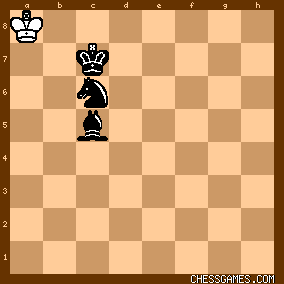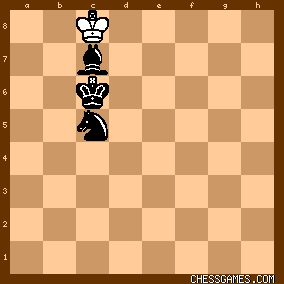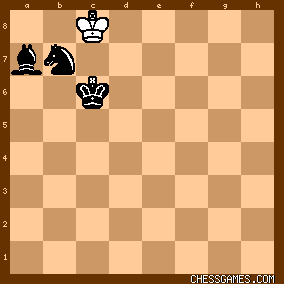|
< Earlier Kibitzing · PAGE 2 OF 2 ·
Later Kibitzing> |
| Aug-15-09 | | Granny O Doul: It was a protest against Dubya. |
|
| Aug-26-09 | | WhiteRook48: interesting |
|
Sep-29-09
 | | Viewer Deluxe: I loved the W-maneuver instructions above and I made them playable and easier to remember (at least for me) http://chesstuff.blogspot.com/2009/... |
|
| Feb-24-10 | | jussu: Wow, I cannot believe it: he actually tried to mate the king in the wrong corner! I guess this can only happen to people who are so talented that they do not need books to learn chess. |
|
| Jul-12-10 | | asiduodiego: What a shame. I've read Jeremy Silman talking about the N+B mate, saying that: "...mastering it would take a significant chunk of time. Should the chess hopeful really spend many of his precious hours he's put aside for chess study learning an endgame he will achieve (at most) only once or twice in his lifetime?". What a waste. This mate, altough very rare, it's very instructive, and, altogether, if you learn the basics, it's not even THAT hard. |
|
Jul-12-10
 | | paulalbert: Frankly,and my rating is 1450, learning how to do this using the big W maneuver with the Knight is not that hard. It's explained very well in Tarrasch's The Game of Chess. The big W ( reflecting the Knight's pattern )is the technique used to drive the opposing K from the wrong colored corner to the other corner where mate is possible. Forcing the opposing K to the corner ( he runs for the wrong colored corner ) also is not that hard using your own K and taking the opposition combined with using your Knight and Bishop to cut off squares. GMs should be able to do this. Botvinnik said if they cannot, then they should be stripped of the GM title, reflecting his high and comprehensive standards for the knowledge a GM should have. Paul Albert |
|
| Dec-07-10 | | Xeroxx: funny. |
|
| Dec-07-10 | | whiteshark: epi' fail |
|
| Dec-07-10 | | BobCrisp: epi-log <flush> |
|
| Apr-22-11 | | wordfunph: one word --- hilarious! |
|
| Jul-03-11 | | swr: After 176...Nb6 White can claim a draw. |
|
| Aug-05-11 | | kevin86: A sad game;surprising that a 2500 player couldn't mate with bishop and knight. The maximum time to force mate with the clergy and calvalry is about 33 moves-with best play by both sides |
|
Aug-05-11
 | | Phony Benoni: Obviously Epishin should have done better, but his play reeks of having literally no time to think rather than carelessness. Consider that by move 126 he had probably been playing for 6 or 7 hours, and would have had very little time or at best a small increment left on the clock. Mastering the principles of the checkmate is easy. But set up the position after move 126 against a friend and give yourself two minutes on the clock. If you can consistently pull it off under those conditions, then you've mastered the ending. |
|
| Feb-22-12 | | whiteshark: <Phony Benoni> I take it that wiser words have never been spoken. Supposably. |
|
| Sep-08-12 | | MarkThornton: Holy-moly! A strong GM failed to win with KBN v K! |
|
| Sep-08-12 | | achieve: <KBN v K mate> Well, to be fair, the "method" can not be invented over the board and potentially in time trouble woes as well, it's too difficult in case you run into a skilled defender... If you have learned it as a kid, assignment by your trainer for example, you may have forgotten the subtleties of hoarding the lone King into a corner, and whether you are an IM or a 2000 player does not matter; although with enough time on the clock a talented GM can probably recall the (preferred Deletang-) method, or else re-invent it OTB. <whiteshark: <Phony Benoni> I take it that wiser words have never been spoken. Supposably.> Likely, yes. |
|
| Oct-01-12 | | King Sacrificer: Is there a technique to drive the king to any corner? |
|
Sep-19-13
 | | Eggman: After 160.Kb8 we reached a position (as earlier in the game) where Black can win with the standard 'W' maneuver: 
click for larger viewUnfortunately Black is very close to violating the 50-move rule at this point, as he must deliver mate by move 176. After 160...Bd4 161.Kc8 Ba7 162.Kd8 Nd5 163.Kc8 Ne7+ 164.Kd8 Kd6 165.Ke8 Ke6 166.Kd8 Bb6+ 167.Ke8 Ba5 168.Kf8 Nf5 169.Ke8 Ng7+ (thus the black knight has moved in a 'W' pattern, via c7-d5-e7-f5-g7) 170.Kf8 Kf6 171.Kg8 Kg6 172.Kf8 Bb4+ 173.Kg8 Nf5 174.Kh8 Ba3 175.Kg8 Nh6+ 176.Kh8 Bb2#, Black delivers mate exactly on the 50th move! The above, however, does not represent White's stiffest resistence. Instead of 163.Kc8 White should play 163.Ke8 (this was played by Nakamura in Ponomariov vs Nakamura, 2011), actually moving toward the mating corner, but briefly escaping from the 8th rank, and now according to the Nalimov tablebase Black cannot deliver mate until move 177, one move too late! |
|
Jul-05-18
 | | Sally Simpson: The Cheltenham Examiner,1st November 1905
https://www.ecforum.org.uk/download... |
|
Oct-13-19
 | | kbob: re king sacrificer Is there a technique to drive a king to any corner? Here are some quick impressions that may help. (1) At first, the knight can get in the way, hold it back and use bishop and king to completely conquer the center (2) Notice that B and N screen out the opposing king most effectively when they are on the same color (3) in addition to the 'W' maneuver with the knight, notice the 'bar' maneuver with the king, constantly advancing in a straight line along the third rank. (4) The bishop is used either to make a waiting move or to deprive the king of front or back door escape squares. (5) Beware of sudden stalemates along the EDGE of the board as well as in the corner |
|
| Oct-13-19 | | Granny O Doul: My board display at the end reads "Three time repetition claimable, White to move Last: 179...Nc8". Must be rare to have "three time (sic) repetition" AND stalemate at the same time. |
|
| Jan-20-21 | | Martin Rattigan: <ToTheDeath>
But the 'W' manoeuvre is NOT correct.
Philidor made two slips in his analysis in terms of accuracy. The first is by White (in this case) at your move 148. He should play <148.Kg7 Be3 (forced to stop 149.Kh6) 149.Kf6>
and Black must waste a move because 149...Bd4 would allow the White king to g5. After 149...Bd2 play would follow the same line but one move later. The second is by Black at your move 153. The waiting move is just a wasted move. He should play <153...Bd8
154.Ke8 Bg5(say)
155.Kf8 Be7+
156.Kg8 (if Ke8 156...Ng7#) Kf6
157.Kh7 Kf7
158.Kh8 Kg6
159.Kg8 Nh6+
160.Kh8 Bf6#>
Mating one move earlier. The knight doesn't move from f5 to g7 completing the 'W', but to h6, so you could say correct is the 'wonky W' manoeuvre, but this is only one of many accurate lines to force the lone king from a wrong corner to a right corner. Of course, the method is not a lot of use if your opponent declines to go to the wrong corner. Incidentally, N-c4-b6 would save you a couple of moves at the start of your sequence. |
|
Jan-21-21
 | | fredthebear: "150...Nd5 is the standard win" just as the notes by Stockfish say, for mate in the a1 corner. 151...Kc6 would have gotten Black on track again for mate in the a1 corner. 156...Nb4+ would have gotten Black on track again for mate in the a1 corner. 178...Nd5 would have gotten Black on track again for mate in the a1 corner. Once the lone king is hemmed in on the edge of the board, the knight leads and the bishop trails, w/the winning king on the 3rd/6th rank or c/f-file. The winning side should not waste energy worrying about the number of moves he's using. Just focus on performing the proper checkmate! The "W" method name comes from the movement of the knight zig-zag. The bishop has some flexibility, but if your knight is on the wrong square, you've got trouble. (The master above tried to mate in the wrong colored corner, which is impossible as he demonstrated.) The stronger king trails slightly or gains the opposition and prevents escape to the inner squares, supporting the knight. The knight takes away the outer squares opposite the color of the bishop, for the most part. Thus, if the bishop takes away the dark squares (mate must be in a dark corner -- same as the bishop), then the knight will take away the light squares. Keep in mind that the knight must change colors every time it moves, so N moves will vary in strength; one move is used to set up the next move. Back in my single days, before computer chess, I'd practice this mate by myself in my apartment. Of course, you should rehearse the proper book instruction by Tarrasch, Reinfeld, Horowitz, Evans, Euwe, etc. over and over first. Set-up the board and replay it straight from the book, night after night, and you'll eventually get it. Take notice of the barriers the knight and bishop form to prevent the lone king from returning to the center. You're not looking for a good move. You're looking to form a barrier that ushers the lone king toward the edge, then send him to the corner the color of the bishop. When by yourself, just play the first legal move available to the lone king (don't think about the lone king's strategy -- just move it legally), then pause as the winning side to consider how to properly respond, restrict/cut-off the lone king. Form a barrier open to the mating corner. Never let the lone king escape out the back end where he came from. Force the lone king to run for it away from your trailing bishop. This is the sort of stuff to practice in the skittles room between rounds. It's a forced checkmate; once the pattern is learned well, any grandmaster with the lone king can be easily defeated in less than two minutes clock time. Stalemates:

click for larger view
click for larger view |
|
Jan-21-21
 | | fredthebear: Here's another Stalemate:

click for larger viewEvaluation: The bishop trails in the ideal position to prevent backtracking. The Black king has the opposition, keeping the White king on the edge of the board. The White knight needs to be on Ne7+ to usher the lone king toward the dark corner h8. If Ne7+ instead of stalemate, the Black king would continue to move sideways on the 6th rank after the White king moved sideways. The Black bishop would continue to take away the trailing dark squares if needed as the contingent moved toward h8. Black to move:

click for larger viewNow is the time to drop the knight back, Nf5.
1...Nf5 2.Ke8 Ng7+
or 1...Nf5 2.Kg8 Kf6 3.Kf8 Ng7 prevents escape out the back. |
|
Nov-29-23
 | | louispaulsen88888888: Besides the well known W manœuvre, the three triangles method is useful, or “ 3 nets”. It’s on YouTube. From the Chess Website, I believe. |
|
 |
|
< Earlier Kibitzing · PAGE 2 OF 2 ·
Later Kibitzing> |





